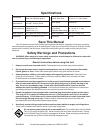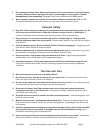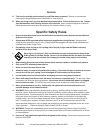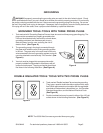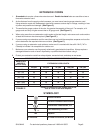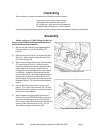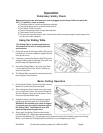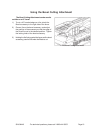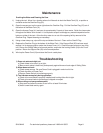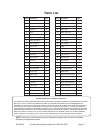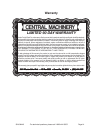
SKU 94443
For technical questions, please call 1-800-444-3353
Page 6
detalusnIelbuoD
noitaicossAsdradnatSnaidanaC
.cnI,seirotarobaLsretirwrednU
tnerruCgnitanretlAstloV
serepmA
n
0
.nim/xxxxetuniMrepsnoituloveRdaoLoN
EXTENSION CORDS
1.
Grounded
tools require a three wire extension cord.
Double Insulated
tools can use either a two or
three wire extension cord.
2. As the distance from the supply outlet increases, you must use a heavier gauge extension cord.
Using extension cords with inadequately sized wire causes a serious drop in voltage, resulting in loss
of power and possible tool damage. (See Figure C.)
3. The smaller the gauge number of the wire, the greater the capacity of the cord. For example, a 14
gauge cord can carry a higher current than a 16 gauge cord. (See Figure C.)
4. When using more than one extension cord to make up the total length, make sure each cord contains
at least the minimum wire size required. (See Figure C.)
5. If you are using one extension cord for more than one tool, add the nameplate amperes and use the
sum to determine the required minimum cord size. (See Figure C.)
6. If you are using an extension cord outdoors, make sure it is marked with the suffix “W-A” (“W” in
Canada) to indicate it is acceptable for outdoor use.
7. Make sure your extension cord is properly wired and in good electrical condition. Always replace a
damaged extension cord or have it repaired by a qualified electrician before using it.
8. Protect your extension cords from sharp objects, excessive heat, and damp or wet areas.
SYMBOLOGY
V ~
A
*SDROCNOISNETXEROFEGUAGERIWMUMINIMDEDNEMMOCER
ETALPEMAN
SEREPMA
)daoLlluFtA(
HTGNELDROCNOISNETXE
teeF52teeF
05teeF57teeF001teeF051
0.2-08181818161
4.3-1.28181816141
0.5-5.38181614121
0.7-1.58161412121
0.21-1.781412101-
0.61-1.21412101--
0.02-1.612101---
CERUGIF
evifotpordegatlovenilehtgnitimilnodesaB*
.serepmadetarehtfo%051tastlov




